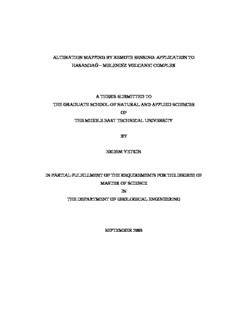Table Of ContentALTERATION MAPPING BY REMOTE SENSING: APPLICATION TO
HASANDAĞ – MELENDİZ VOLCANIC COMPLEX
A THESIS SUBMITTED TO
THE GRADUATE SCHOOL OF NATURAL AND APPLIED SCIENCES
OF
THE MIDDLE EAST TECHNICAL UNIVERSITY
BY
ERDEM YETKİN
IN PARTIAL FULFILLMENT OF THE REQUIREMENTS FOR THE DEGREE OF
MASTER OF SCIENCE
IN
THE DEPARTMENT OF GEOLOGICAL ENGINEERING
SEPTEMBER 2003
Approval of the Graduate School of Natural and Applied Sciences
__________________
Prof. Dr. Canan ÖZGEN
Director
I certify that this thesis satisfies all the requirements as a thesis for the degree of
Master of Science.
__________________
Prof. Dr. Asuman G. TÜRKMENOĞLU
Head of Department
This is to certify that we have read this thesis and that in our opinion it is fully
adequate, in scope and quality, as a thesis for the degree of Master of Science.
___________________________ __________________________
Assist. Prof. Dr. M. Lütfi SÜZEN Assoc. Prof. Dr. Vedat TOPRAK
Co-Supervisor Supervisor
Examining Committee Members
Assoc. Prof. Dr. Vedat TOPRAK _____________________
Assist. Prof. Dr. Mustafa Türker _____________________
Assist. Prof. Dr. M. Lütfi SÜZEN _____________________
Dr. Arda ARCASOY _____________________
Dr. Mesut SOYLU _____________________
ABSTRACT
ALTERATION MAPPING BY REMOTE SENSING: APPLICATION TO
HASANDAĞ – MELENDİZ VOLCANIC COMPLEX
Yetkin, Erdem
M.Sc., Department of Geological Engineering
Supervisor: Assoc. Prof. Dr. Vedat Toprak
Co-Supervisor: Assist. Prof. Dr. M. Lütfi Süzen
September 2003, 94 pages
Certain alteration minerals are used to identify the hydrothermally altered rocks.
Potassic, phyllic (sericitic), propylitic, argillic and silicification are main
alteration types observed in volcanic rocks. The role of remote sensing in
alteration mapping is the differentiation of the minerals that are unique for
different alteration types.
In this study, Landsat TM 5 images are used. General alteration trend in the area
is mapped by conventional methods of color composite, band rationing,
principal component analysis and multi-linear regression analysis.
Detailed mineral mapping carried on by using the United States Geological
Survey (USGS) spectral library data. Spectral reflectances of selected minerals
are analyzed according to the TM band intervals and appropriate band ratios are
selected. TM bands 1,2,3,4,5 and 7 are used. Outputs of mineral maps are
investigated for zonal distribution.
iii
Mineral maps that are obtained by the mineral separation method reveal that the
youngest volcanic complex Hasandağ is poorly altered. Instead, Keçiboyduran,
Melendiz and Tepeköy volcanic complexes are found to be highly altered with
the pattern of clay dominant in the center and increasing oxidation towards
flanks. Also the alteration along the previously mapped buried faults is a proof
that the method can provide information about the alteration source.
Key Words: Remote sensing, alteration mapping, spectral library, Cappadocian
Volcanic Province.
iv
ÖZ
UZAKTAN ALGILAMA İLE ALTERASYON HARİTALAMASI:
HASANDAĞ – MELENDİZ VOLKANİK KOMPLEKSİNE UYGULANMASI
Yetkin, Erdem
Yüksek Lisans, Jeoloji Mühendisliği Bölümü
Tez Yöneticisi: Doç. Dr. Vedat Toprak
Ortak Tez Yöneticisi: Y. Doç. Dr. M. Lütfi Süzen
Eylül 2003, 94 sayfa
Kayaçlarda hidrotermal sıvıların neden olduğu alterasyonun belirlenmesinde
belli başlı alterasyon mineralleri kullanılır. Potassik, fillik (serizitik), propilitik,
arjillik, gelişmiş arjillik, silisleşme, volkanik kayaçlarda görülen belli başlı
alterasyon tipleridir., Alterasyon haritalamasında uzaktan algılamanın rolü, her
tipin kendine has olan alterasyon minerallerinin ayıklanmasıdır.
Bu çalışmada Landsat TM 5 uydusunun görüntüleri kullanılmıştır. Genel
alterasyon haritalamasında renk kompozisyonu, bant oranlaması, temel
bileşenler analizi ve multilineer regresyon gibi konvansiyonel yöntemler
uygulanmıştır.
Ayrıntılı mineral haritalaması ‘United States Geological Survey’ (USGS)
spektral kütüphane datası kullanılarak yapılmıştır. Seçilen minerallerin
spektrumları Landsat TM’in bant aralıklarına göre detaylı bir şekilde incelenmiş
ve buna uygun bant oranları seçilmiştir. Elde edilen mineral haritaları daha sonra
alansal dağılım açısından incelenmiştir.
v
Uygulanan mineral ayıklama yöntemi ile elde edilen mineral haritaları
göstermiştir ki, en genç volkanik kompleks olan Hasandağ kompleksi alterasyon
açısından en bakir alandır. Bunun yanında Keçiboyduran ve Melendiz
kompleksleri merkezde kil ağırlıklı, eteklere doğru oksitçe zengin bir alterasyon
zonlanması gösterir. Bölgede önceki çalışmalardan tesbit edilmiş gömülü fay
doğrultuları boyunca gözlenen alterasyon da yöntemin, bozunma kaynağı ile
ilgili yorumlara da katkı sağlayabileceğinin göstergesidir.
Anahtar kelimeler : Uzaktan algılama, alterasyon haritalaması, spektral
kütüphane, Kapadokya Volkanik Provensi.
vi
DEDICATION
To my beloved family members
vii
ACKNOWLEDGEMENTS
For the endless energy he has in supporting, motivating and teaching me I am
very grateful and very lucky to have worked with my supervisor Assoc. Prof. Dr.
Vedat Toprak.
I would like to thank to my co-supervisor Assist. Prof. Dr. Lütfi Süzen for his
guidance in the dark valleys of altered images.
I would like to thank to Dr. Arda Arcasoy for his valuable comments at the
critical stages of the thesis.
I would like to express my appreciation to Dr. Mesut Soylu for changing my
point of view in geology.
Also I would like to thank to Deniz Gerçek for helping me dealing with the
script writing.
I would like to express my sincere thanks to my family for their un-writable
tolerance and support.
viii
TABLE OF CONTENTS
ABSTRACT........................................................................................................iii
ÖZ..........................................................................................................................v
DEDICATION....................................................................................................vii
ACKNOWLEDGEMENTS..............................................................................viii
TABLE OF CONTENTS.....................................................................................ix
LIST OF TABLES............................................................................................xiii
LIST OF FIGURES............................................................................................xiv
LIST OF ABBREVIATIONS...........................................................................xvii
CHAPTER
1. INTRODUCTION........................................................................................1
1.1. Purpose and Scope.............................................................................1
1.2. Study area..........................................................................................2
1.3. Method of Study................................................................................3
1.4. Organization of thesis........................................................................3
2. REGIONAL GEOLOGY.............................................................................5
2.1. Previous Works.................................................................................5
2.2. Geological Setting.............................................................................8
2.3. Rock Units.......................................................................................10
2.3.1. Volcaniclastics.........................................................................10
2.3.2. Volcanic complexes................................................................12
ix
2.3.3. Volcanic cone fields................................................................12
2.3.4. Plio-Quaternary continental deposits......................................13
2.4. Tectono-Volcanic Framework.........................................................13
2.4.1. Faults.......................................................................................13
2.4.2. Volcanic Activity....................................................................14
2.5. Geology of “Hasandağ-Melendiz Volcanic Complex”...................17
2.5.1. Basalts.....................................................................................17
2.5.2. Andesitic basalts and andesites...............................................17
2.5.3. Volcanic cone breccias............................................................17
2.5.4. Tuff Breccias...........................................................................18
2.5.5. Radial ash flow of Hasandağ complex....................................18
2.5.6. Ash formation of Hasandağ complex......................................19
2.5.7. Ash flow tuffs of Hasandağ.....................................................19
2.5.8. Volcanic agglomerate and conglomerates of Keçiboyduran
volcanic complex.....................................................................................19
2.5.9. Pyroclastic formation of Melendiz complex...........................19
2.5.10. Viterous tuffs of Melendiz volcanic complex.........................20
2.5.11. Agglomerates of Melendiz volcanic complex.........................20
3. ALTERATION MAPPING BY USING REMOTE................................21
3.1. Alteration of Rocks.........................................................................21
3.2. Alteration Types..............................................................................22
3.3. Techniques of Remote Sensing in Alteration Mapping..................23
3.3.1. Remote Sensing Technology...................................................23
3.3.1.1. The Landsat Satellites.........................................................25
3.3.2. Present Techniques in Alteration Mapping.............................30
3.3.2.1. Color Composites................................................................30
x
Description:THE DEPARTMENT OF GEOLOGICAL ENGINEERING is mapped by conventional methods of color composite, band rationing, principal Melendiz and Tepeköy volcanic complexes are found to be highly altered with Key Words: Remote sensing, alteration mapping, spectral library, Cappadocian.

